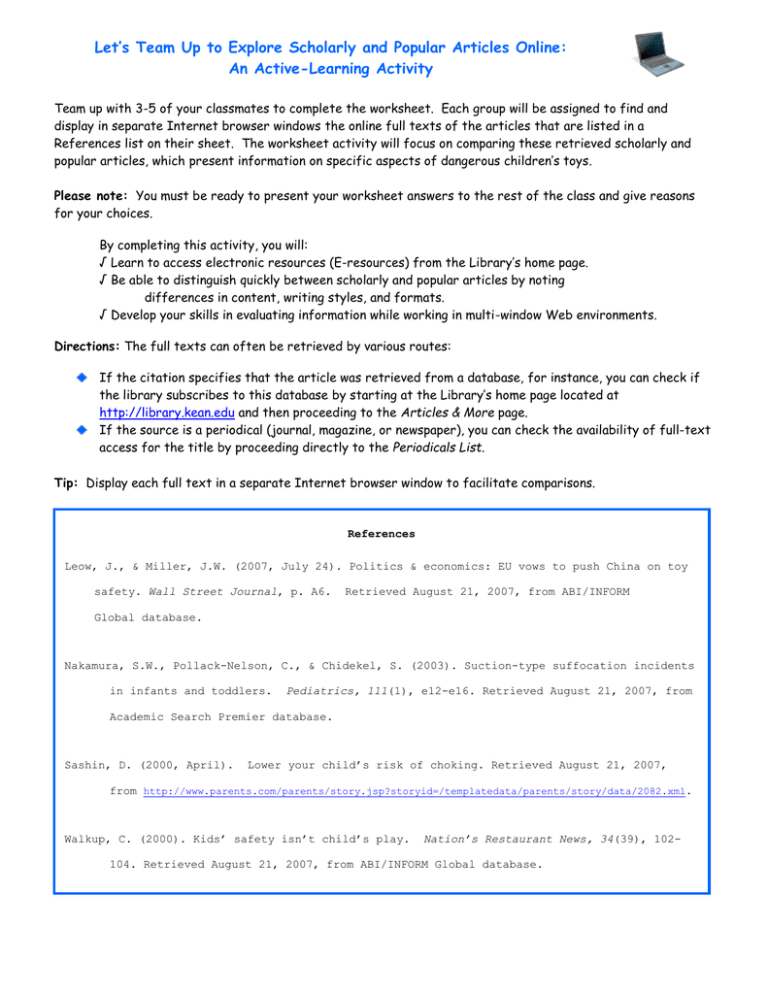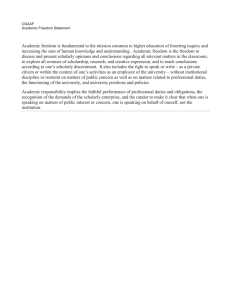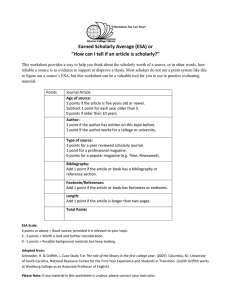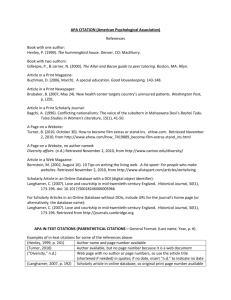Let’s Team Up to Explore Scholarly and Popular Articles Online:
advertisement

Let’s Team Up to Explore Scholarly and Popular Articles Online: An Active-Learning Activity Team up with 3-5 of your classmates to complete the worksheet. Each group will be assigned to find and display in separate Internet browser windows the online full texts of the articles that are listed in a References list on their sheet. The worksheet activity will focus on comparing these retrieved scholarly and popular articles, which present information on specific aspects of dangerous children’s toys. ______ Please note: You must be ready to present your worksheet answers to the rest of the class and give reasons for your choices. By completing this activity, you will: √ Learn to access electronic resources (E-resources) from the Library’s home page. √ Be able to distinguish quickly between scholarly and popular articles by noting differences in content, writing styles, and formats. √ Develop your skills in evaluating information while working in multi-window Web environments. Directions: The full texts can often be retrieved by various routes: If the citation specifies that the article was retrieved from a database, for instance, you can check if the library subscribes to this database by starting at the Library’s home page located at http://library.kean.edu and then proceeding to the Articles & More page. If the source is a periodical (journal, magazine, or newspaper), you can check the availability of full-text access for the title by proceeding directly to the Periodicals List. Tip: Display each full text in a separate Internet browser window to facilitate comparisons. References Leow, J., & Miller, J.W. (2007, July 24). Politics & economics: EU vows to push China on toy safety. Wall Street Journal, p. A6. Retrieved August 21, 2007, from ABI/INFORM Global database. Nakamura, S.W., Pollack-Nelson, C., & Chidekel, S. (2003). Suction-type suffocation incidents in infants and toddlers. Pediatrics, 111(1), e12-e16. Retrieved August 21, 2007, from Academic Search Premier database. Sashin, D. (2000, April). Lower your child’s risk of choking. Retrieved August 21, 2007, from http://www.parents.com/parents/story.jsp?storyid=/templatedata/parents/story/data/2082.xml. Walkup, C. (2000). Kids’ safety isn’t child’s play. Nation’s Restaurant News, 34(39), 102- 104. Retrieved August 21, 2007, from ABI/INFORM Global database. Worksheet Hint: Discuss your findings with your teammates before answering. Using the sources listed in your references: 1. Identify the source for the article that is a study: ______________________________________ 2. Identify the source for the informative news article, but that is not refereed or peer-reviewed for quality by a select group of experts: ______________________________________ 3. Identify the source for the article that provides advice for parents rather than original research: ______________________________________ 4. Identify the source for the article that provides a bibliography: ______________________________________ 5. Identify the source that is a trade or professional magazine: ______________________________________ 6. Identify the source for the article that provides an acknowledgements section: ______________________________________ 7. Identify the source for the article that has photos of smiling faces and that contains a few cartoons: ______________________________________ 8. Identify the source for the article that provides a clearly labeled summary at its beginning: ______________________________________ 9. Identify the source for the article that lists either the credentials or academic affiliations of the author(s): ______________________________________ 10. Identify the source for the article that uses scholarly language relating to a specific academic discipline: ______________________________________ Using your answers to the first ten questions, answer these three questions. Remember: You must be ready to explain your answers to the rest of the class and give reasons for your choices. 1. 2. Identify the source for the article that your team deems most scholarly: ______________________________________ What visual cues did your team use to identify a scholarly source? List these cues here: ______________________________________ ______________________________________ ______________________________________ ______________________________________ ______________________________________ ______________________________________ 3. Define a scholarly article? Note: Use a separate piece of paper to answer this question. Copyright © 2007, Kean University Library. Created by Caroline Geck, August 23, 2007.



